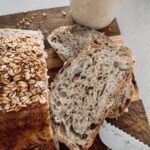
Easy Multigrain Sourdough Recipe
Filled to the brim with grainy goodness, this easy multigrain sourdough recipe is everything you want in grainy bread. It's totally customisable so you can add the seeds and grains you love to eat.
Servings 1 Loaf
Calories 2304kcal
Equipment
- Mixing Bowl
- Banneton
- Dutch Oven
Ingredients
- 50 g Sourdough Starter Active and Fed
- 500 g Bread Flour
- 350 g Water
- 10 g Salt
- 25 g Whole Rolled Oats
- 25 g Pumpkin Seeds
- 25 g Sunflower Seeds
- 25 g Rolled Flax Seeds
- 10 g Hemp Seeds
- 10 g Sesame Seeds
- 10 g Poppy Seeds
- Additional Seeds of choice for topping your sourdough.
Instructions
- Before You Start: Before you start this bake, you'll need to soak your seeds and oats in about 100g of water. Only soak pumpkin, sunflower, flax and oats (not poppy seeds, sesame seeds or hemp). Just leave them for around an hour. They will soak up all of the water in this time.
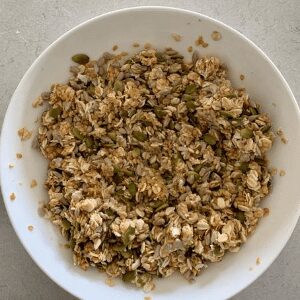
- Autolyse: Weigh out your sourdough starter and water into a large ceramic or glass bowl. Mix the water and starter together briefly. Then add your flour and salt and mix altogether with a silicone dough scraper. The dough will be fairly shaggy and only just brought together (see photo).Cover your bowl with cling film or a damp tea towel and let it sit for around 1 hour.
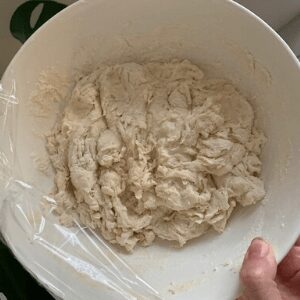
- Adding Your Seeds:After the dough has been through autolyse you will need to add your seeds. If there is still water sitting in the bowl of seeds, drain it off. The seeds will be quite wet but this will help them incorporate into the dough.Put all the seeds and oats into the middle of the bowl and work your way around, folding the dough over the seeds and oats and incorporating them into the dough.Don't worry if your seeds haven't worked through the dough fully, they will be evenly distributed when you complete the stretch and folds.Once the dough has formed into a ball, pop the cling film back on and let it rest for 30 minutes.
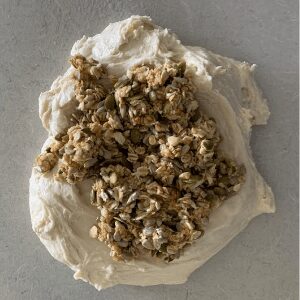
- Stretch & Folds:Over the next few hours you need to create some structure for your dough by "stretching and folding". Aim to do around 4-6 sets of stretches and folds. For each set, stretch the dough up and over itself 4 times. Leave around 15 minutes in between each set. You do not have to be exact with time, but you need to do at least 4 sets over 2 hours.
- Bulk Ferment:Once you've finished your stretch and folds, place the cling film or damp tea towel back over your dough and let it rest and ferment (see notes).
- Shaping Your Dough:Once your dough has finished its first ferment, it's time to form it back into a ball and give it some shape and surface tension. You'll need to flour your counter top with rice flour for this (we use rice flour because it has no gluten). Try to be quite sparing with the rice flour, you only need a very light dusting.Use a silicone dough scraper to gently ease the dough out of the bowl. You want it to land upside down on your counter so that the smooth top of the dough is on the countertop and the sticky underside is facing up. This will make it easier to shape.You want to pull the edges of the dough into the centre and then flip it over so that the sticky side is now underneath. Using the stickiness, gently pull the dough into a tight ball.
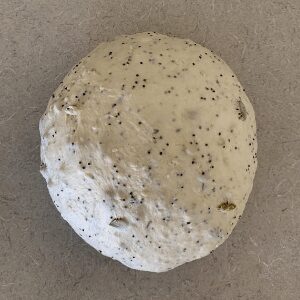
- Adding Topping:You will need a banneton to put your dough into. If you do not have a banneton, then a bowl or basket lined with a floured tea towel is perfectly fine. Make sure your bowl isn't too big though, you want your dough to retain some shape.Whatever you're using needs to be liberally floured with your rice flour. Then, add the seeds you'd like on the top of your sourdough to the bottom of the banneton.Place your dough, seam side up into the bannton.This will allow the seeds to stick to the top of the dough, so when you flip it out to bake, they won't all fall off.
- Cold Ferment:Now your dough is in it's "shaping container" cover it loosely with a plastic bag or damp tea towel and place into the fridge. I use a large plastic bag to cover it - I just reuse it each time. It's not totally essential to cover it - you can place it in the fridge uncovered if you'd prefer.Try to leave it in the fridge for a minimum 5 hours up to a maximum of around 36 hours. The longer you leave it the better your bread will be! A longer cold ferment creates beautiful blisters on your crust and a deeper sourdough flavour. It will also ensure your dough forms a skin which makes it easier to score. For this multigrain bread, I highly recommend leaving your dough in the fridge for 36 hours - it creates the most amazing flavor!
- Preparing to Bake:Once you're ready to bake your sourdough, you'll need to preheat your oven to 230C/450F. Place your Dutch Oven into the oven when you turn it on so it gets hot. Try to preheat for around 1 hour to ensure your oven is super hot - but you know your oven so just adjust this time if you need to. Leave your dough in the fridge until the very last minute - placing a cold dough into a hot oven will give you a great "spring".
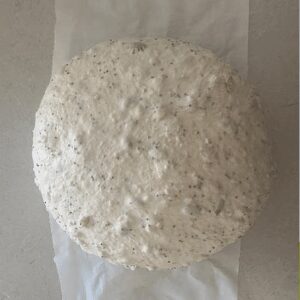
- Scoring Your Sourdough:Now it's time to score! When your oven is at temperature, take your sourdough out of the fridge. Gently flip your dough out onto a piece of parchment paper so that the seeded top is facing up.Make sure that you make the baking paper big enough to use the edges as a handle to lower to dough into your Dutch Oven.Gently score your bread with a lame, clean razor blade or knife. At minimum a large cross is sufficient, but you can get as artistic as you like (although it can be hard with a seeded loaf). Try to score it fairly deep to ensure the dough opens up.
- Baking Your Sourdough:Carefully take your dutch oven out of the oven. Place the sourdough into the pot using the baking paper as a handle. Put the lid on and place into the hot oven. If you want to you can spritz your dough with extra water before you put the lid on.If you're worried about the base of your bread burning, place a baking sheet on shelf underneath your Dutch Oven - it works!BAKE TIME:30 Minutes with the lid on at 230C/450F plus10-15 Minutes with the lid off at 210C/410F
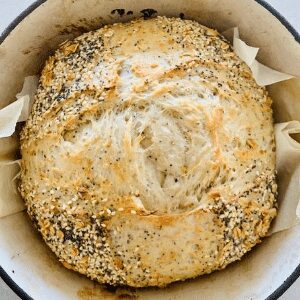
- Finishing Your Bake:When you remove your dough from the oven, carefully remove it from the dutch oven as soon as possible and place on a wire rack to cool.
Notes
- Notes on Sourdough Starter
This recipe is based on you having an active starter that you have fed a few hours before starting your bake. For information on whether your starter is ready, go here. - Notes on Stretch & Folds
If you are going to do the stretch & folds on your bench top, spray your surface with water mist rather than using flour. - Notes on Bulk Fermentation: If your home is warm then your dough will ferment a lot faster and could be done in as little as a few hours. If it's colder, it will take longer, possibly overnight. I would recommend that you try to do your first few bulk ferments during daylight hours so that you can watch your dough closely. Once you're more familiar with the process - and the temperature of your home - you will be able to do overnight ferments. You will know your dough is ready to move to the next stage when it has *just* doubled in size. It will be fairly wobbly and full of bubbles. You should be able to see large air bubbles under the surface of the dough. You don't want to let it go any further than doubled as it will be over fermented. If you want to do an overnight ferment, but your home is warm, consider using a little less starter (ie 25g). Less starter means your dough will take longer to ferment and you will reduce the risk of over fermenting your dough. You'll find more information on these topics here: When is my bulk ferment finished? What is the difference between cold ferment and bulk ferment? Why does the amount of starter matter?
- Notes on Baking
If you're worried about the base of your bread burning, place a baking sheet on shelf underneath your Dutch Oven - it works! If you're worried about your bread not being cooked all the way through, turn the oven off and place your dough straight onto the oven rack.
Leave the door ajar and let your bread rest there for a few hours.
Remember not to cut into your loaf too soon - you'll need to let it cool for at least a few hours (4-6 is best).
Nutrition
Calories: 2304kcal | Carbohydrates: 386g | Protein: 81g | Fat: 47g | Saturated Fat: 6g | Trans Fat: 1g | Sodium: 3912mg | Potassium: 983mg | Fiber: 19g | Sugar: 3g | Vitamin A: 79IU | Vitamin C: 1mg | Calcium: 374mg | Iron: 12mg